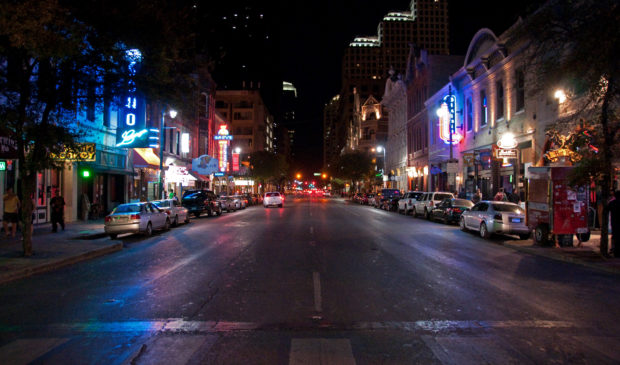Ingredients for safer Sixth Street include daytime activities, alternate land uses
Wednesday, October 27, 2021 by
Chad Swiatecki The city hopes a plan to increase daytime non-drinking activity, promote a variety of land uses and coordinate safety plans with bar owners will lead to a safer atmosphere in the Sixth Street entertainment district.
Following a recent report to City Council from Chief Joseph Chacon on Austin Police Department’s progress on improving safety in the district, the Downtown Commission received an update that focused on programming, public works and activating vacant spaces as some of the possible steps that could be used in coming years.
Brian Block, the city’s manager of entertainment services, said a variety of city departments are collaborating to fulfill the objectives set out by Council following a mass shooting on Sixth Street in June that killed one tourist and injured a dozen others.
Block said public safety components such as increasing lighting and increasing the presence and coordination of emergency services during crowded nighttime bar hours would work. There are also plans afoot to make the area more pedestrian friendly and active in the daytime with activities such a farmers market, which is being explored by the Pecan Street Owners Association.
Improved public space design, partnerships with bar owners to coordinate security protocols, and bringing theater or varied other uses into the area are the broad strokes of the plan Council expects to see by the end of the month. In particular, Block identified the many vacant storefronts between Interstate 35 and Red River Street as a target for pop-ups or alternative uses, with some programming likely to fold into live music promoted in the nearby Red River Cultural District.
Commissioners were in favor of the plans and offered a variety of guidance for staff, with Commissioner David Gomez pushing for Austin Public Health to be involved in safety planning related to intoxication and other high-risk behaviors.
“The bad stuff happens when people aren’t in their right mind, whether it’s because they drank too much or not,” he said. “As you talk about training door personnel … if there was consistency in how behaviors were dealt with from bar to bar so people didn’t know that if you go to this bar you can get away with a lot more, that would lead to better outcomes.”
Chair August Harris asked staff to research how many bars are operating on Sixth Street and how much of the total commercial square footage they represent in the district, with Block saying that data could also be paired with head counts and alcohol sales data to get a better understanding of usage patterns.
“Everybody around here has seen all the changes that have happened to Sixth Street over the years and the bars so often change where they’re hot one year and fade the next year and then bring in another operator and concept, so there’s this constant ebb and flow,” he said. “I love the idea of making sure everyone understands an emergency plan and communication plan, but obviously the turnover in bars is very high. And so maintaining that consistently is going to be absolutely critical.”
Harris said the city needs to focus on the environment and activities in adjoining alleys and parallel streets since public safety issues can travel between downtown entertainment districts.
“So much of the safety issues is what happens behind Sixth Street, whether it’s in parking lots or areas that need more sufficient lighting,” he said. “It goes down to Second Street, down to Fourth Street and covers West Sixth Street as people migrate back and forth between the bars that are still open.”
Photo made available through a Creative Commons license.
The Austin Monitor’s work is made possible by donations from the community. Though our reporting covers donors from time to time, we are careful to keep business and editorial efforts separate while maintaining transparency. A complete list of donors is available here, and our code of ethics is explained here.
You're a community leader
And we’re honored you look to us for serious, in-depth news. You know a strong community needs local and dedicated watchdog reporting. We’re here for you and that won’t change. Now will you take the powerful next step and support our nonprofit news organization?







